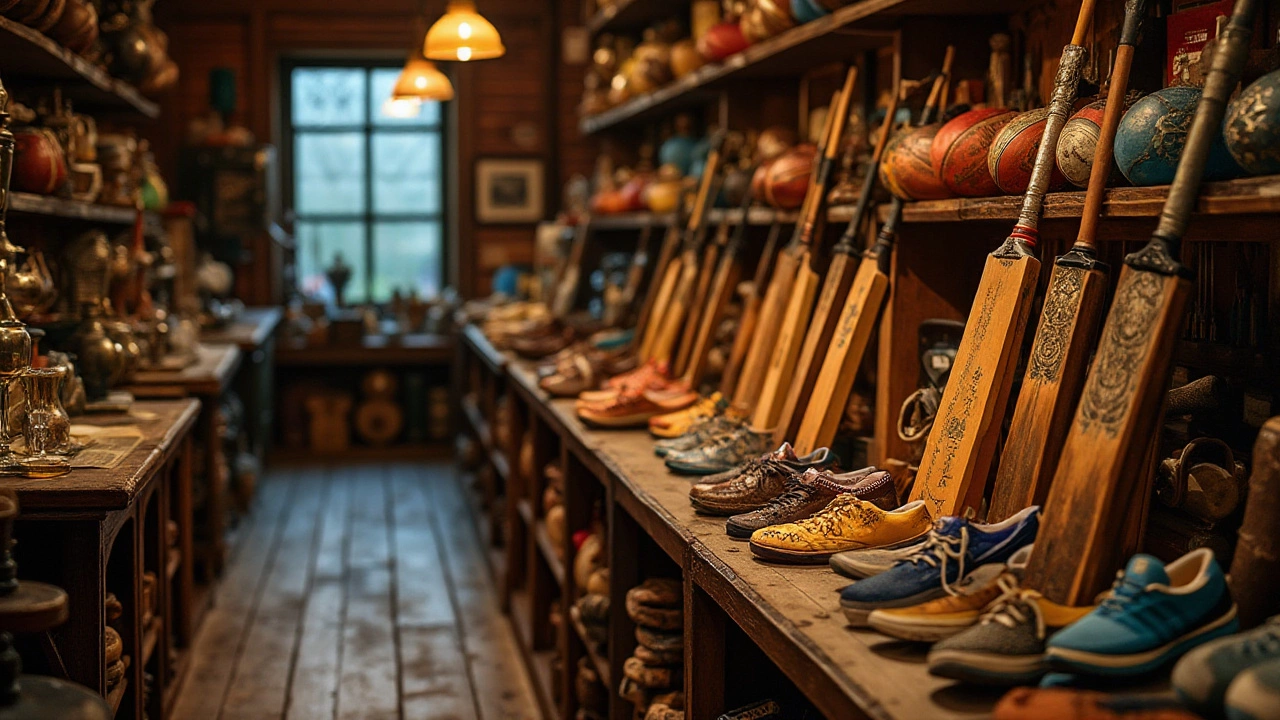Essential Sports Equipment: Must-Have Items for Every Athlete
 Jan, 2 2025
Jan, 2 2025
When it comes to maximizing athletic performance, the right sports equipment is as vital as a good training schedule. Each sport, whether it's soccer, tennis, or high-intensity workouts, demands specific gear that not only aids in better performance but also ensures safety. From the helmet protecting a cyclist to the tennis racket used on a championship court, these items are meticulously designed to suit their unique environments.
Over the years, sports equipment has evolved dramatically. Innovations in materials and technology have transformed simple items into sophisticated gear aimed at enhancing athletic prowess while minimizing the risk of injuries. Knowing what to look for when choosing sports equipment can make a significant difference in your athletic experience. This guide will help you navigate through the must-have sports items and provide insights into their importance and features.
- Introduction to Sports Equipment
- Protective Gear Essentials
- Equipment for Various Sports
- Innovative Exercise Tools
- Choosing Quality Over Quantity
- Caring for Your Sports Gear
Introduction to Sports Equipment
Sports have been a cornerstone of human culture for centuries, providing both recreation and a venue for competition. Over time, the equipment used in these activities has evolved, driven by the need to improve performance and ensure safety. Whether you're a casual player or a competitive athlete, understanding the role of sports equipment is crucial in maximizing both enjoyment and effectiveness in any sport.
The significance of sports items extends beyond mere functionality. Each piece is a product of extensive research and development, aimed at enhancing the athlete's capabilities while minimizing risks. For instance, the introduction of new-generation materials like carbon fiber has revolutionized everything from the design of bicycles to tennis rackets, making them lighter and more responsive. These advancements have not only reshaped the gear but have also set new standards in performance metrics across various sports.
"In sports, the right equipment can be the difference between good and great," noted renowned sports scientist Dr. Jane Smith in her survey on sports technology advancements. "It's fascinating to see how these tools have evolved to meet the demands of modern athletes."
Moreover, certain sports have equipment that defines them. Think of cricket without its iconic bat, or basketball without its hoop and net. The equipment doesn't just play a functional role; it also adds to the identity and essence of the sport. This pivotal role underscores the importance of choosing the right gear not only in terms of personal preference but also in relation to the specific demands of each sport.
For those stepping into the world of fitness and sport, knowing where to start with athlete gear can be daunting. It’s a common misconception that the most expensive gear is always the best. In reality, what matters most is selecting equipment tailored to your specific needs and activity. Beginners should focus on must-have items like comfortable, breathable attire, adequate footwear specific to the sport, and basic protective gear. As your expertise grows, investing in more advanced equipment becomes logical.
Understanding the historical context of sports equipment also sheds light on its development. Centuries ago, athletes had more rudimentary options, relying heavily on natural materials. For instance, the first soccer balls were sewn from animal bladders, and early protective helmets were crafted from leather. These humble beginnings sparked a transformative journey that has led to today’s high-tech gear, built from synthetic and engineered materials offering unparalleled performance and protection.
Modern Innovation in Sports Equipment
The drive for constant improvement in sports gear has transformed fields into laboratories for innovation. Companies compete vigorously to produce equipment that offers reduced drag, more precision, or enhanced durability.Innovative exercise tools like wearable technology provide athletes real-time feedback on their performance metrics, empowering them to optimize their strengths and address weaknesses swiftly. For example, modern track shoes can boost sprinting through their aerodynamic design combined with specially engineered rubber soles.
Any serious athlete or sports enthusiast understands the critical role that proper gear plays. As you become more invested in your sport, deeper attention to the precision and functionality of your sporting tools becomes necessary. This attention not only enhances your performance but also solidifies your understanding of the gear's importance in the grand tapestry of athletic excellence.
Protective Gear Essentials
When it comes to engaging in sports, ensuring your safety should always be a priority. Protective gear is crucial, not only in contact sports like American football and hockey but also in activities where injuries might seem less probable, such as cycling or even running. These items are specifically designed to safeguard athletes against common injuries, which are frequently encountered during physical activities. For instance, helmets are a key element in many sports, offering critical head protection against impacts that can lead to concussions. The evolution of helmets is particularly fascinating, with advancements incorporating durable yet lightweight materials such as polycarbonate and carbon fiber. These improvements have significantly enhanced protection without compromising comfort.
In addition to helmets, mouth guards play a vital role in sports like boxing, rugby, and basketball, where facial impacts are common. A mouth guard helps in protecting the teeth and jaw while also preventing more serious injuries to the lips and tongue. Advances in dental protection now offer custom-fit options that provide greater comfort and effectiveness compared to generic alternatives. According to the American Dental Association, athletes are sixty times more likely to suffer dental injuries if they're not wearing a mouth guard. This statistic underscores the necessity of including such protective items in your sports kit.
Padding, such as shin guards and shoulder pads, serves as a barrier against impacts in sports like soccer and American football. These pieces are critical for protecting vulnerable parts of the body during gameplay. Modern sports pads utilize high-impact foam and thermoplastic materials to effectively absorb shock and reduce the risk of fractures or bruises. Moreover, with the use of breathable fabrics, today's protective sports gear ensures that athletes can maintain optimum performance without being hindered by discomfort.
"The right protective gear isn't just about safety; it's about confidence. Athletes who trust their armor can focus entirely on the game." — National Athletic Trainers' Association
For sports like skiing and snowboarding, goggles are indispensable. They protect the eyes from intense sunlight, snow, and other debris that might impair vision. Recent innovations have introduced interchangeable lenses and anti-fog coatings, allowing athletes to adapt swiftly to changing weather conditions. Equally, for swimmers, goggles help in providing clear vision underwater while shielding the eyes from chlorine and other chemicals.
One cannot overlook the importance of proper footwear as part of protective sports equipment. Shoes designed with cushioned soles and ankle support are fundamental for reducing the risk of injury in a variety of sports including running, basketball, and tennis. Proper footwear supports the foot's natural dynamics, providing much-needed balance and shock absorption. The right pair can prevent conditions like sprains and stress fractures, which are prevalent in high-impact sports. Therefore, investing in quality footwear is an essential step for any avid sports enthusiast.

Equipment for Various Sports
When diving into the world of sports, the myriad of sports equipment available can quickly become overwhelming. Each sport requires specific items tailored to its unique demands. Take, for example, the game of soccer. Beyond the ball, players rely on cleats that provide the necessary grip on grassy fields, shin guards to protect against stray kicks, and uniforms designed to wick away sweat. In contrast, a basketball player’s essential gear involves a high-quality basketball, shoes with superior ankle support for quick lateral movements, and durable, anti-slip jerseys.
For outdoor enthusiasts who gravitate towards cycling, the bicycle represents just the start. Helmets are non-negotiable in terms of safety, padded shorts for comfort during long rides, and clipless pedals to enhance pedaling efficiency. In tennis, the selection of a racket becomes a deeply personal choice influenced by grip size, string tension, and the weight of the racket itself. It's also crucial to have the right tennis balls, while shoes are constructed to withstand the unique side-to-side movements demanded by the sport.
What's particularly fascinating is how innovative technologies have seeped into the very fabric of these items. For instance, modern running shoes are engineered with materials that are both lightweight and provide maximum cushioning. They are designed to absorb shock, thus reducing the risk of injury. Many brands also incorporate pattern designs on the heel or sole to cater to different running styles, whether you're a heel-striker or a forefoot runner. Quoting a well-renowned sports expert from the International Association of Athletics Federations, "The advancement in shoe technology has significantly lessened the impact of running on joints, allowing athletes to go the extra mile without the worry of injuries."
Another testament to the progression in sports equipment is evident in golf. The modern-day golf club features a scientific combination of metals in its construction, designed to maximize distance and accuracy. Similarly, the dimples on the golf ball play a crucial role in its aerodynamics, managing lift and drag during flight. Moreover, GPS watches have revolutionized the way golfers approach their game, allowing for precise measurements of distance on the course, thereby improving strategy.
Delving into water sports, surfers depend on wetsuits that offer thermal protection in cold waters while being flexible enough to allow freedom of movement. Advanced designs in surfboards now include carbon fiber technology, serving enthusiasts ranging from novice to professional to brave the waves with increased maneuverability and speed. Within this equipment, attention to detail and a commitment to performance are standard, ensuring participants of each sport are optimally equipped to excel in their field.
Innovative Exercise Tools
In the past decade, the realm of sports equipment has witnessed intriguing transformations, especially with the advent of innovative exercise tools. These tools are designed not just for functionality, but also for enhancing the exercise experience itself. Take, for instance, the humble yoga mat. What once was a simple piece of rubber or foam has now been integrated with advanced technologies like grip-enhancing designs and antimicrobial surfaces. Such advancements ensure that athletes maintain the best hygiene and performance during their workouts. Notably, the fusion of technology and fitness isn't limited to traditional gym equipment. Wearable technology, such as fitness trackers and smart watches, has become indispensable in monitoring vital stats, providing real-time feedback that helps tailor workouts to individual needs.
Another fascinating development is the rise of interactive and digital fitness platforms. Tools like the Peloton bike or the Mirror Home Gym have revolutionized indoor workouts by combining the physical aspect of exercising with engaging digital content. Users can now participate in live classes, compete with others across the globe, and even receive personalized coaching from the comfort of their homes. This blend of digital and physical dimensions expands the horizon for what is possible within a workout regime.
"The integration of technology into fitness has nonpareil potential to revolutionize not just how we exercise, but how we view our personal capabilities," says Jane Bryan, a renowned fitness futurist.Such advancements have made workouts more accessible, engaging, and effective.
Moreover, innovative tools like resistance bands and kettlebells are taking the concept of portability to new levels. These items are lightweight yet effective, making it easier for anyone to carry their workout equipment wherever they go. They emphasize versatility and adaptive resistance, providing users with varied and comprehensive routines without the need for bulky machines. For someone on the go or lacking space, such compact solutions present a unique advantage. Additionally, the environmental impact of sports gear production has become a significant concern. Therefore, many manufacturers are now offering eco-friendly alternatives made from sustainable materials, balancing performance with responsibility. This consideration is reshaping the choices athletes make concerning their sports equipment. Whether it's a simple adjustable dumbbell or a sophisticated virtual reality fitness headset, the focus remains on improving the quality of the workout experience while being mindful of wider implications.

Choosing Quality Over Quantity
In the world of sports equipment, the age-old debate between quality and quantity is more relevant than ever. With a myriad of choices available, it's easy to get overwhelmed. Yet, the principle of quality over quantity stands out as a beacon of practical wisdom. Investing in high-quality gear often equates to better performance, durability, and safety, aspects that are fundamental for any athlete. A top-tier pair of running shoes, for instance, can provide the support and comfort needed to prevent injuries and enhance athletic prowess. These benefits aren't typically found in cheaper, lower-quality alternatives. Furthermore, there is a sustainable element to consider; fewer replacements mean less waste in the long run.
Choosing the best sports items involves understanding the materials and technologies used in their construction. High-performance sports gear often incorporates advanced materials such as carbon fiber, which offers tremendous strength without adding excessive weight. Additionally, investing in reputable brands can ensure access to ergonomic and scientifically tested designs that can make a real difference in your game. While quality gear often comes with a higher price tag, the return on investment, in terms of performance enhancement and longevity, invariably justifies the cost. Dave Smith, a seasoned sports coach, once said,
"Buying quality sports equipment is like investing in your personal success story."His words encapsulate the philosophy that quality gear aids in achieving athletic goals.
Another consideration when prioritizing quality is the impact on performance metrics. Studies suggest that athletes who use high-quality gear can experience a noticeable improvement in efficiencies, such as speed and endurance, due to the optimized fit and enhanced features of their equipment. This is particularly important in competitive sports where fractions of a second can make a difference. Additionally, quality gear often comes with warranties or satisfaction guarantees, providing peace of mind to athletes in case the equipment does not perform as expected.
To evaluate the quality of sports items, one can rely on expert reviews, customer feedback, and comparison guides. Insights from professionals who have tested the equipment in real-world conditions are invaluable for making an informed choice. Many outdoor enthusiasts, for instance, swear by rigorous reviews from seasoned hikers before purchasing gear like backpacks and footwear. A practical tip is to prioritize equipment that utilizes cutting-edge technology and has been endorsed by professionals in the field. This ensures that the product is reliable and effective, ultimately saving money and preventing possible injuries from using subpar gear.
Meanwhile, quantity, though tempting to accumulate, often results in clutter and wasted resources. A streamlined set of essential, well-chosen items can cater to most athletic needs without overwhelming the user. Consider what gear is truly necessary for your sport or activity, and focus on items that can provide maximum benefit. In conclusion, quality sports equipment is paramount for anyone who takes performance and safety seriously. Make informed decisions and embrace a philosophy that values longevity, efficacy, and satisfaction above sheer numbers. Remember that each piece of athlete gear is an extension of the athlete's spirit, designed to pave the way towards success, one stride, stroke, or swing at a time.
Caring for Your Sports Gear
Proper care for your sports equipment is essential not just for maintaining its functionality, but also for extending its lifespan. Whether it's athlete gear or high-tech sports items, they deserve routine maintenance to ensure they’re always at the ready when you push your limits. For instance, regularly cleaning exercise tools can prevent bacteria buildup, while protective gear such as helmets and pads demand periodic inspection for wear and tear. A good rule of thumb is to dedicate time every month to check over all your gear for signs of damage or the need for adjustments.
Let's talk about cleaning techniques which are vital for longer-lasting equipment. With myriad materials used in sports equipment, it’s important to use appropriate cleaning methods for each type. For example, leather requires different care than synthetic fabrics. Most equipment can benefit from a basic wipe down with a damp cloth, but some items, like clothing or certain protective gear, might require soap and water or even specialized cleaners. Drying gear thoroughly after cleaning is equally important, as moisture can lead to unpleasant odors or even mold. An often-overlooked fact is that sunlight can degrade certain materials, so try to air-dry in shaded areas whenever possible.
Storage plays a crucial role in gear longevity. Keeping your equipment in a dry, cool space helps maintain its structural integrity. Investing in proper storage solutions like racks for bicycles or designated bins for smaller items not only keeps your equipment organized but also ensures it stays in good condition. Additionally, temperature fluctuations can be detrimental to materials used in sports items such as balls and rackets, so make sure your storage area is temperature-regulated.
"Your sports gear is like a team member – treat it well, and it will always have your back," aptly put by a seasoned coach.
Finally, regular inspections are key. Before each use, give your gear a quick once-over to check for issues. With items like helmets, inspect for cracks, loose padding, or compromised straps. For equipment like rackets and bats, look for distorted frames or splintering. Timely identification of such problems not only mitigates the risk of injury but also sometimes offers a chance for repair instead of replacement. This simple but often forgotten step can make all the difference to both your performance and your pocketbook.
For those deeply invested in specific sports, sometimes consulting with professionals about equipment upkeep is beneficial. Experts can advise on advanced care techniques for specialized equipment, such as restringing tennis rackets or resealing skis. Often, athlete gear specialists can also provide advice on when it is economically wiser to replace rather than repair, ensuring your performance and safety aren’t compromised. Remember, the better you care for your gear, the more it will contribute to your sporting experience.